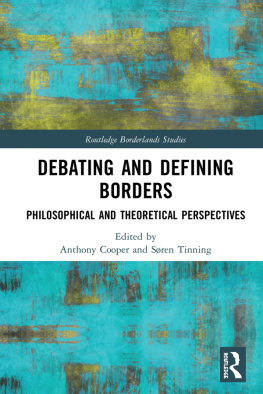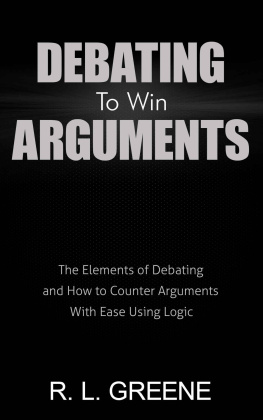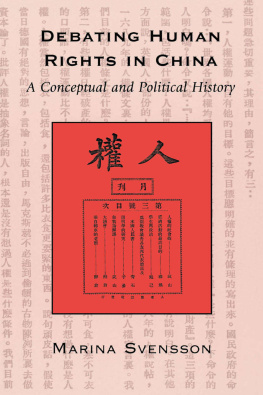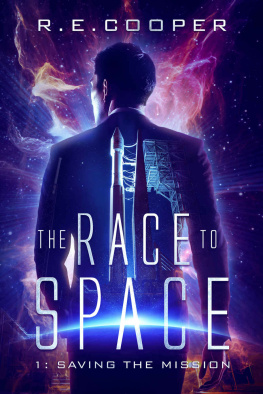Anthony Cooper - Debating and Defining Borders
Here you can read online Anthony Cooper - Debating and Defining Borders full text of the book (entire story) in english for free. Download pdf and epub, get meaning, cover and reviews about this ebook. year: 2019, publisher: Taylor & Francis (CAM), genre: Politics. Description of the work, (preface) as well as reviews are available. Best literature library LitArk.com created for fans of good reading and offers a wide selection of genres:
Romance novel
Science fiction
Adventure
Detective
Science
History
Home and family
Prose
Art
Politics
Computer
Non-fiction
Religion
Business
Children
Humor
Choose a favorite category and find really read worthwhile books. Enjoy immersion in the world of imagination, feel the emotions of the characters or learn something new for yourself, make an fascinating discovery.
- Book:Debating and Defining Borders
- Author:
- Publisher:Taylor & Francis (CAM)
- Genre:
- Year:2019
- Rating:3 / 5
- Favourites:Add to favourites
- Your mark:
- 60
- 1
- 2
- 3
- 4
- 5
Debating and Defining Borders: summary, description and annotation
We offer to read an annotation, description, summary or preface (depends on what the author of the book "Debating and Defining Borders" wrote himself). If you haven't found the necessary information about the book — write in the comments, we will try to find it.
Debating and Defining Borders — read online for free the complete book (whole text) full work
Below is the text of the book, divided by pages. System saving the place of the last page read, allows you to conveniently read the book "Debating and Defining Borders" online for free, without having to search again every time where you left off. Put a bookmark, and you can go to the page where you finished reading at any time.
Font size:
Interval:
Bookmark:
Anthony Cooper and Sren Tinning
Borders have always had a contested but central role in society and the overlapping politics of mobility, identity, economy and citizenship (Bauder, 2011), and they continue to do so. Borders have not succumbed to transnational flows and forces or, for that matter, our increased awareness of the world as a single place (Robertson, 1992). Yet they are much more complex than the time-honoured idea of them being the neatly tessellating territorial outer edges of nation states, depicted as taken for granted limit-lines to be observed from above and, more often than not, from a geographical and cognitive distance. In order to study the complexity of borders in our global age, research has been required to accommodate an expansion of different perspectives, approaches and concepts, perhaps most notably captured by the conceptual shift from borders as territorial lines to bordering as socio-cultural processes, practices and discourses (Brambilla, 2015; Paasi, 2011; Scott, 2012). In this regard, contemporary and increasingly interdisciplinary border studies laconically defined by van Houtum (2005, 672) as the study of human practices that constitute and represent differences in space observes bordering not simply in the distant geopolitical affairs of (and between) territorial states but in the messy here-and-now micro-politics of everyday life practices and experiences. The interdisciplinary emphasis on process, practice and experience means that contemporary borders are observed as multiple and multiplied: They are studied from multiple disciplinary, theoretical and methodological vantage points (Newman, 2006a, 2006b). They have multiplied in terms of their location, form, function and ownership (Cooper, Perkins and Rumford, 2014). They mean different things to different people (Balibar, 2002) and may not be visible to everyone (Rumford, 2012). And, fundamentally building on the previous point, the diversity of practices that make, and are made by, bordering produce a multiplicity of border versions and subsequent meanings that cannot be reified (Andersen, Klatt and Sandberg, 2012, 7; Bauder, 2011; Rumford, 2012; Sohn, 2015).
The more we research and think about the multiplicity of borders, however, the more ambivalent they become as research objects (see Paasi, 2009, 217). In their opening section of the multi-authored article Interventions on Rethinking the Border in Border Studies, Jones and Johnson (2011, 1) argue that the recent expansion of scholarship concerned with understanding borders has enriched border studies but, at the same time, obscured our understanding of what a border is. Chris Rumford (2012, 891) has similarly pointed out that in the contemporary context far less consensus exists on what constitutes a border, where borders are to be found, or which borders are the most important. While general questions and discussions relating to the who, where and why of bordering are contested but reasonably commonplace, particularly in terms of border securitisation, the question of what is a border remains problematic and somewhat vexed. The danger is, of course, that theorising borders in terms of defining the border is, by definition, to define the limits of a discipline that is necessarily open and interdisciplinary given the subject matter. For many, border studies is not a coherent discipline but a loose framing exercise across the social sciences and humanities. At the same time, defining the border in and of itself risks the sort of universal theorising and generalisation theoretical grandstanding that would render borders oversimplified and de-historicised, stripping them of their meaning, practice and experience. The theory becomes unhelpful and unnecessary as well as empirically inaccurate and non-scientific. The point is that while borders may be dynamic, complex and multiple, they can be concretely understood only in their particular context (see Wastl-Walter, 2011, 1). It seems that the diversity and strong contextual determination of borders (and the study of them) makes broader theoretical elaborations problematic and even unviable. Nevertheless, we think that studying borders theoretically is fruitful, and pursuing questions such as what defines a border beyond its identity (Sohn, 2015, 9) can benefit the interdisciplinary study of borders generally.
There are two principal and overlapping aims of this book. In the first instance, the aim is to approach the study of borders theoretically and philosophically, with particular attention given to the concept of the border in and of itself (although it by no means excludes empirical engagement and discussion). The broad argument here is that general border studies contains a serious theoretical and philosophical challenge regarding the definition of its very object of study and it is this theoretical-cum-philosophical challenge to which the chapter contributors have been invited to respond. Placing the border more centrally in this way, as the principal object of study, avoids the danger of theoretical dilution and the tendency to subsume borders to other, wider concepts such as nationalism, sovereignty, state security, citizenship and globalisation and so on (see Rumford, 2012), although these are by no means separate.
The second, more specific aim, is to provide a dialogue between and a resource for border scholars and philosophers. In doing so, we wish to counteract the surprisingly limited involvement of philosophy as a discipline in the interdisciplinary field of border studies, despite the fact that the study of borders has continuously intersected with philosophical ideas, not least, for example, in the relationship between the Cartesian concept of space and the border as an abstract and strictly defined line. More importantly, we want to argue here that the open question of the border touched upon above that the concept of the border cannot be fashioned into an overarching coherent concept provides fertile ground for philosophical enquiry. The theoretical question of borders is open but far from barren. If one is to take Nietzsches call to reinvigorate the inadequate (or mummified) concepts of the tradition and replace them with new and living metaphors (Nietzsche, 2005), then the theoretical study of borders is very much alive. In fact, new concepts and metaphors are proliferating within border studies. Older concepts such as boundary, limit, threshold, and edge are being re-elaborated, and new metaphors such as flows, networks, bordering, membranes, sutures, borderlands and borderscapes are being introduced to capture and understand the complexity and multiplicity of borders (see, for example, Noel Parkers chapter in this volume). To this end, each contributor has put forward their own theoretical response to the what is question regarding the concept of the border.
In this regard, none of the chapters to follow proposes or advocates an overarching theory of borders, or, for that matter, attempts to define or sketch out the limits of disciplinary study. Nevertheless, there is strong agreement across all of the chapters that universality, understood in the classical sense of all things/notions being the same in all cases, does not equal theory or even a theoretical foundation for a discipline. Across the philosophical traditions such as hermeneutics, phenomenology and post-structuralism, to name but a few, there is a long-standing effort to challenge universality without renouncing theory. These traditions have been utilised to theorise and understand the temporal/historical and spatial/place-like phenomena of the social world that exploits theoretical openness and expands our understanding of their inherent, always inchoate nature without the imposition of theoretical fixity (often in the guise of conceptual maturity). In other words, there are plenty of useful and applicable theoretical possibilities within philosophy, whose claim to universality may be that they are more adequate than traditional theory in defining non-universal phenomena/objects such as borders. The remainder of this introductory chapter will proceed as follows. The next section briefly outlines the way in which the concept of the border has been developed and theorised before detailing some reasons why the introduction of philosophical enquiry to border studies provides added value to the way borders are currently theorised. The final section will serve to introduce the individual chapters.
Font size:
Interval:
Bookmark:
Similar books «Debating and Defining Borders»
Look at similar books to Debating and Defining Borders. We have selected literature similar in name and meaning in the hope of providing readers with more options to find new, interesting, not yet read works.
Discussion, reviews of the book Debating and Defining Borders and just readers' own opinions. Leave your comments, write what you think about the work, its meaning or the main characters. Specify what exactly you liked and what you didn't like, and why you think so.














